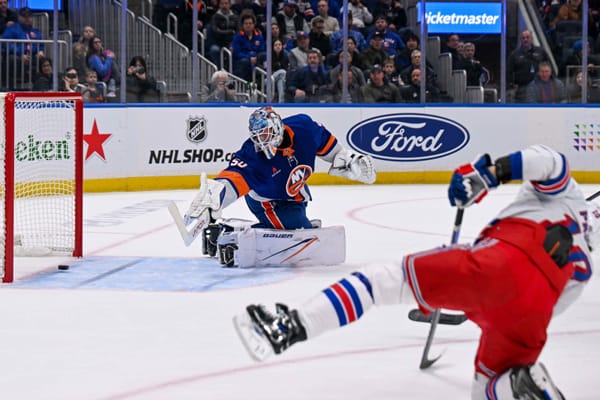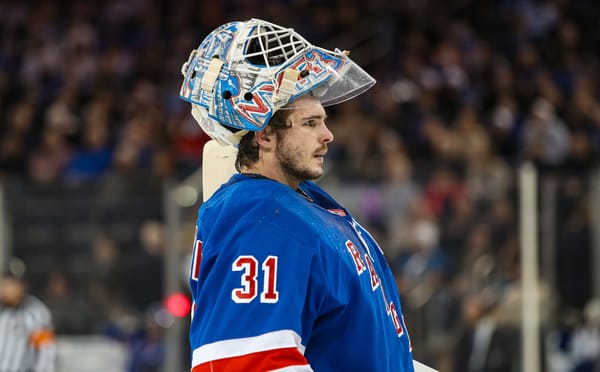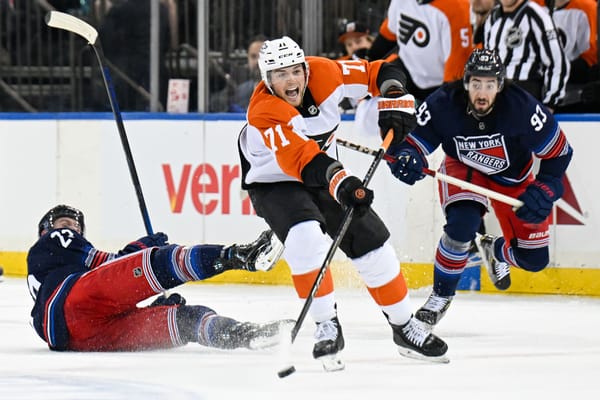Summer 2017 New York Rangers Prospect Rankings: 24-21
So here’s the deal. The first article was supposed to be players ranked 38 through 31. That would have set up five players per article the rest of the way. However, I accidentally added in 30 as well. As a result, the numbers are skewed. So, I am only including four players in this article to correct the course. Feel free to throw all of your tomatoes at me in the comments section. Nonetheless, I had a lot to say about these four players and you will be plenty occupied.
24. Dominik Lakatos, Center, 20 Years Old, Sixth-Round Pick (2017)
Previous Rank: N/A
Though the Rangers drafted both Morgan Barron and Brandon Crawley before Lakatos, I’m going to go against the grain a little bit and put him above them.
Lakatos spent virtually all of last season as a 19-year-old playing against grown men in the Czech league, and he performed reasonably well. In the regular season, he racked up 10 goals and 12 assists. He really turned it on in the playoffs, though, with eight goals and five assists in 16 games. I know that the Rangers’ scouting staff loves it when a prospect plays his best hockey towards the end of the season and shows growth. In respect to the scoresheet, Lakatos fit the part. Our European correspondent, Alex Nunn, put some video together of Lakatos’ playoff goals.
Here are all eight playoff goals by #NYR sixth-round selection Dominik Lakatoš from this past season. Consistent theme. pic.twitter.com/2pNbglGycJ
— Alex Nunn (@aj_ranger) June 25, 2017
It’s clear from the video that Lakatos loves to be a net-front presence. He puts himself in positions to score, whether off of screens, passes or rebounds. He loves to engage with defenders and battle for territory.
Beyond that, he plays the typical game of a grinder. As mentioned, he drives to the net. He likes to hit players and battle one-on-one in the corners. He has a reputation as a bit of a hothead, but he’s not completely out of control. A little volatility isn’t a bad thing. It worked out well for Brad Marchand and Sean Avery, among many others. Lakatos will have to find the balance, and hopefully he will as he outgrows his teen years and matures.
Work has been done to study what kinds of players towards the end of the draft tend to have NHL careers. Findings aren’t concrete, but many have found that overage forwards tend to have the best chance of graduating to the NHL.
(10/10) From 1990-2010, 50% of successful forwards picked after Rd 2 were re-entry players. No coincidence the Leafs took 5 of them in 2016.
— Jake Goldberg (@Jake__Goldberg) June 28, 2016
It checks out intuitively. An older player has more on his resume and is more polished, and therefore is less of an unknown. The downside is that these players tend to lack upside. Late in the draft, though? Grabbing any kind of NHL talent would be a steal.
Lakatos, drafted as a freshly turned 20-year-old, qualifies as an overage forward. Thus, I like the pick both philosophically and individually. He’s already been a contributing part of a championship team in a quality men’s league. He plays the type of style that is sustainable in tighter North American games. Lakatos seems like the kind of player who could be cultivated into a bottom-six forward at the NHL level.
23. Tarmo Reunanen, Defenseman, 19 Years Old, Fourth-Round Pick (2016)
Previous Rank: 15
At the start of the 2015-2016 season, Reunanen was a projected top-60 pick in the 2016 draft. Massive injuries derailed his season, and so he fell to the Rangers in the fourth round. The recovery toll carried over into the 16-17 season. Here is what Reunanen told the New York Rangers’ website.
"It was a tough season [last year]," Reunanen told NYRangers.com after the final day of prospect development camp. "Last summer I was not able to practice 100 percent. At the gym, I wasn't able to do squats with any weights. The confidence was not good at the start of the season.”
As a result, Reunanen did not make the lineup for TPS in the top Finnish league, and instead played in Finland’s second division. Furthermore, he was never realistically in the running for Finland’s U20 World Juniors team.
Even if this was all disappointing, it was understandable and part of the accepted risk the Rangers took on when they drafted him. They knew they would have to be patient with Reunanen. He’ll have the entire summer to get back to full strength and then some. Without the injuries, he was a dynamic puck-moving defenseman. The expectation for next season is that he’ll feature for TPS in Finland’s main league, where 2017 draft pick Tony Patrik Virta also plays. Currently, he is on Finland’s roster for their U20 summer exhibition games. The hope is that he puts on a strong display as he tries to earn a spot in the 2018 U20 World Junior Championship squad.
22. Ty Ronning, Right Wing, 19 Years Old, Seventh-Round Pick (2016)
Previous Rank: 21
Last season was a good one for Ronning. He played on an absolutely terrible Vancouver Giants team in the WHL, which meant he didn’t have much help around him. However, that meant he was relied on to play a prominent role that he might not have gotten on a better team. In 68 games he registered 25 goals and 28 assists. Those are respectable numbers, and given his linemates he undoubtedly earned that production his own merit.
His best showing came from his AHL cameo in the spring, however. Given the poor state of the team, Ronning was given an opportunity in a top-six role. In 12 games with the Wolf Pack, he was consistently one of the team’s better players. Two goals and three assists adds up to decent production for his first pro stint on a bad team. He also proved that the size gap - Ronning is 5’9 and 170 by the most forgiving measure - wasn’t enough to write him off. He did a lot of great forechecking work. In the neutral zone, his positioning was good and he forced his share of turnovers or dump-ins. This video of him (#7 in black) epitomizes his work ethic. He’ll go in 1v2 against guys much bigger than he is and force a turnover by himself.
The Rangers have some options for what to do with Ronning next season. Turning 20 in October, he could go back to the WHL for what would technically be an overage season. Given his previous stint in Hartford, it’s more likely that he starts the year in the AHL. We’ll also see if the Rangers give him an NHL contract this summer or instead challenge him to earn it next season. It’s still too early to figure out Ronning’s NHL prospects but the Rangers can feel pretty good about his development a year removed from taking him with one of the last picks in the draft.
21. John Gilmour, Defenseman, 24 Years Old, Free-Agent Signing (2016)
Previous Rank: N/A
The Rangers signed Gilmour out of Providence College last summer after the Calgary Flames, who drafted him, opted to let his rights expire. He had a pretty good first AHL season on a dysfunctional Wolf Pack team. His skating is by far his best asset. Quick, short strides help him push up the ice with serious momentum, and he is confident with the puck on his blade.
In the offensive zone, he moves the puck well from the point as well. He has an understanding of when to activate and become a passing option down low. His defensive game needs work. Though the speed is there to keep up with NHLers, he didn’t show the strength and defensive awareness that necessary. That would be considered a work in progress if he were 20. At 24, though, it’s a big concern.
The problem for Gilmour is that he’s in the wrong place at the wrong time. In the last five months, the Rangers have added five different defensemen who have superseded him on the depth chart. Gilmour is nearing his mid-20s, so there’s not much time for patience. For now, he’s a quality AHL defenseman, but it’s hard to see a path to Madison Square Garden for him unless he really turns some heads next season.




